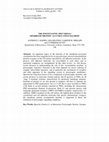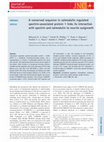Papers by Gareth Phillips

Cellular & molecular biology letters, 2001
One aspect of spectrin/4.1/ankyrin function is to act as an "accumulation machine" at the plasma ... more One aspect of spectrin/4.1/ankyrin function is to act as an "accumulation machine" at the plasma membrane by recruiting selected transmembrane proteins to sites specified by cell adhesion molecules, and stablizing them by linkage to the internal cytoskeleton [1]. In the nervous system, an important site of intercellular adhesion is the synapse. Spectrin has long been known to be a component of postsynaptic densities (PSDs), and it is established that βIΣ2 spectrin is in PSDs. More recently we have shown that βIIΣ1, but not βIIΣ2 spectrin, is a PSD component [2]. These observations raise the question of whether the spectrin-binding 4.1 proteins are also PSD components. We find that specific isoforms of each 4.1 protein (4.1R, 4.1B, 4.1N and 4.1G) are enriched in PSDs [3]. An 80 kDa form of 4.1R is enriched in PSDs to an extent comparable with the standard PSD marker PSD-95. 4.1R co-immunoprecipitates with βIIΣ1 spectrin, actin and the characteristic intermediate filament of PSDs, α-internexin (αI). This provides the first description of a mechanism linking αI to the PSD core. PSD spectrin/4.1 proteins bind glutamate receptors: βIIΣ1 spectrin binds NMDA receptors; 4.1 binds AMPA receptors. We hypothesize that the spectrin/4.1 "accumulation machine" bridges glutamate receptors to cytoplasmic αI and actin, thereby promoting their retention at synapses.

European Journal of Biochemistry, 2001
At the C-terminus of all known 4.1 proteins is a sequence domain unique to these proteins, known ... more At the C-terminus of all known 4.1 proteins is a sequence domain unique to these proteins, known as the C-terminal domain (CTD). Mammalian CTDs are associated with a growing number of protein±protein interactions, although such activities have yet to be associated with invertebrate CTDs. Mammalian CTDs are generally defined by sequence alignment as encoded by exons 18±21. Comparison of known vertebrate 4.1 proteins with invertebrate (Caenorhabditis elegans and Drosophila melanogaster) 4.1 proteins indicates that mammalian 4.1 exon 19 represents a vertebrate adaptation that extends the sequence of the CTD with a Ser/ Thr-rich sequence. The CTD was first described as a 22/24-kDa domain by chymotryptic digestion of erythrocyte 4.1 (4.1R) [Leto, T.L. & Marchesi, V.T. (1984) J. Biol. Chem. 259, 4603±4608]. Here we show that in 4.1R the 22/24-kDa fragment is not stable but rapidly processed to a 15-kDa fragment by chymotrypsin. The 15-kDa fragment is extremely stable, being resistant to overnight digestion in chymotrypsin on ice. Analysis of this fragment indicates that it is derived from residues 709±858 (SwissProt accession no. P48193), and represents the CTD of 4.1R. The fragment behaves as a globular monomer in solution. Secondary-structure predictions indicate that this domain is composed of five or six b strands with an a helix before the most C-terminal of these. Together these data indicate that the CTD probably represents an independent folding structure which has gained function since the divergence of vertebrates from invertebrates.

Mammalian Genome, 2005
The spectrin-based cytoskeleton assembly has emerged as a major player in heart functioning; howe... more The spectrin-based cytoskeleton assembly has emerged as a major player in heart functioning; however, cardiac protein 4.1, a key constituent, is uncharacterized. Protein 4.1 evolved to protect cell membranes against mechanical stresses and to organize membrane microstructure. 4.1 Proteins are multifunctional and, among other activities, link integral/signaling proteins on the plasma and internal membranes with the spectrin-based cytoskeleton. Four genes, EPB41, EPB41L1, EPB41L2, and EPB41L3 encode proteins 4.1R, 4.1N, 4.1G, and 4.1B, respectively. All are extensively spliced. Different isoforms are expressed according to tissue and developmental state, individual function being controlled through inclusion/exclusion of interactive domains. We have defined mouse and human cardiac 4.1 transcripts; other than 4. 1B in humans, all genes show activity. Cardiac transcripts constitutively include conserved FERM and C-terminal domains; both interact with membrane-bound signaling/transport/cell adhesion molecules. Variable splicing within and adjacent to the central spectrin/actin-binding domain enables regulation of cytoskeleton-binding activity. A novel heart-specific exon occurs in human 4.1G, but not in mouse. Immunofluorescence reveals 4.1 staining within mouse cardiomyocytes; thus, both at the plasma membrane and, interdigitated with sarcomeric myosin, across myofibrils in regions close to the sarcoplasmic reticulum. These are all regions to which spectrin locates. 4.1R in human heart shows similar distribution; however, there is limited plasma membrane staining. We conclude that cardiac 4.1s are highly regulated in their ability to crosslink plasma/integral cell membranes with the spectrin-actin cytoskeleton. We speculate that over the repetitive cycles of heart muscle contraction and relaxation, 4.1s are likely to locate, support, and coordinate functioning of key membrane-bound macromolecular assemblies.

Journal of Neurochemistry, 2002
Spectrin isotypes segregate in neurons and are differentially distributed between axons and somat... more Spectrin isotypes segregate in neurons and are differentially distributed between axons and somatodendritic compartments. Their functions in those compartments are likely to be mediated by proteins that interact selectively with one or other isotype. Fodaxin (an axonspecific protein previously termed A60) colocalizes in CNS neurons with axonal spectrin and in vitro binds brain spectrin (a mixture of al, /31, all, and /311 polypeptides) but not erythrocyte spectrin (al and /31). Because all and /311 spectrin polypeptides are enriched in axons, we investigated a possible binding of fodaxin to the types of spectrin found in axons. Fodaxin did not bind to isolated brain a chains. Bacterially expressed C-terminal segments 18-19 of /311 spectrin bound to fodaxin and inhibited the binding of fodaxin to whole brain spectrin. By contrast, recombinant segments 18-19 of the somatodendritic /3l~2 spectrin showed no interaction with fodaxin. Within /311, fodaxin binding activity was localized to residues 2,087-2,198, which are unique to /311 and link between the end of segment 18 and the pleckstrin homology domain in segment 19. The divergent regions of sequence in segments 19 of /311 and /3l~2are candidates to mediate the isotype-specific functions of spectrin. Fodaxin is the first protein to be described that discriminates between the unique regions of /3 spectrin isoforms.

Cellular & molecular biology letters, 2001
An important aspect of the function of the membrane-associated cytoskeleton has been suggested to... more An important aspect of the function of the membrane-associated cytoskeleton has been suggested to be to trap and retain selected transmembrane proteins at points on the cell surface specified by cell adhesion molecules. In the process, cell adhesion molecules are cross-linked to each other, and so junctional complexes are strengthened. In this short review, we will discuss recent advances in understanding the role of this "accumulation machine" in postsynaptic structures. Function in the brain depends on correct ordering of synaptic intercellular junctions, and in particular the recruitment of receptors and other apparatus of the signalling system to postsynaptic membranes. Spectrin has long been known to be a component of postsynaptic densities, and recent advances in molecular cloning indicate that beta spectrins at PSDs are all "long" C-terminal isoforms characterised by pleckstrin homology domains. Isoforms of protein 4.1 are also present at synapses. All fou...

Journal of Neurochemistry, 2013
Calmodulin regulated spectrin-associated protein 1 (CAM-SAP1) is a vertebrate microtubule-binding... more Calmodulin regulated spectrin-associated protein 1 (CAM-SAP1) is a vertebrate microtubule-binding protein, and a representative of a family of cytoskeletal proteins that arose with animals. We reported previously that the central region of the protein, which contains no recognized functional domain, inhibited neurite outgrowth when over-expressed in PC12 cells [Baines et al., Mol. Biol. Evol. 26 (2009), p. 2005]. The CKK domain (DUF1781) binds microtubules and defines the CAM-SAP/ssp4 family of animal proteins (Baines et al. 2009). In the central region, three short well-conserved regions are characteristic of CAMSAP-family members. One of these, CAMSAPconserved region 1 (CC1), bound to both bIIΣ1-spectrin and Ca 2+ /calmodulin in vitro. The binding of Ca 2+ /calmodulin inhibited spectrin binding. Transient expression of CC1 in PC12 cells inhibited neurite outgrowth. siRNA knockdown of CAMSAP1 inhibited neurite outgrowth in PC12 cells or primary cerebellar granule cells: this could be rescued in PC12 cells by wild-type CAMSAP1-enhanced green fluorescent protein, but not by a CC1 mutant. We conclude that CC1 represents a functional region of CAMSAP1, which links spectrin-binding to neurite outgrowth.

Molecular Biology and Evolution, 2009
We describe a structural domain common to proteins related to human calmodulin-regulated spectrin... more We describe a structural domain common to proteins related to human calmodulin-regulated spectrin-associated protein1 (CAMSAP1). Analysis of the sequence of CAMSAP1 identified a domain near the C-terminus common to CAMSAP1 and two other mammalian proteins KIAA1078 and KIAA1543, which we term a CKK domain. This domain was also present in invertebrate CAMSAP1 homologues and was found in all available eumetazoan genomes (including cnidaria), but not in the placozoan Trichoplax adherens, nor in any nonmetazoan organism. Analysis of codon alignments by the sitewise likelihood ratio method gave evidence for strong purifying selection on all codons of mammalian CKK domains, potentially indicating conserved function. Interestingly, the Drosophila homologue of the CAMSAP family is encoded by the ssp4 gene, which is required for normal formation of mitotic spindles. To investigate function of the CKK domain, human CAMSAP1-enhanced green fluorescent protein (EGFP) and fragments including the CKK domain were expressed in HeLa cells. Both whole CAMSAP1 and the CKK domain showed localization coincident with microtubules. In vitro, both whole CAMSAP1-glutathione-s-transferase (GST) and CKK-GST bound to microtubules. Immunofluorescence using anti-CAMSAP1 antibodies on cerebellar granule neurons revealed a microtubule pattern. Overexpression of the CKK domain in PC12 cells blocked production of neurites, a process that requires microtubule function. We conclude that the CKK domain binds microtubules and represents a domain that evolved with the metazoa. Materials and Methods Bioinformatics Genomic or cDNAsequences were retrieved from Ensembl (Hubbard et al. 2002
Regulatory Toxicology and Pharmacology, 2012
This is the report from the ''ECVAM-EFPIA workshop on 3T3 NRU Phototoxicity Test: Practical Exper... more This is the report from the ''ECVAM-EFPIA workshop on 3T3 NRU Phototoxicity Test: Practical Experience and Implications for Phototoxicity Testing'', jointly organized by ECVAM and EFPIA and held on the 25-27 October 2010 in Somma Lombardo, Italy. The European Centre for the Validation of Alternative Methods (ECVAM) was established in 1991 within the European Commission Joint Research, based on a Communication from the European Commission (1991). The main objective of ECVAM is to promote the scientific and regulatory acceptance of alternative methods which are of importance to the biosciences and which reduce, refine and replace the use of laboratory animals.
Applied Microbiology and Biotechnology, 1993
Hen egg white lysozyme was expressed as a protein fusion with the OmpA signal sequence and an oct... more Hen egg white lysozyme was expressed as a protein fusion with the OmpA signal sequence and an octapeptide linker in Escherichia coli. The expression yielded soluble and enzymatically active lysozyme. Lysozyme activity was detected in the periplasmic space, in the cytosol and in the insoluble cytosolic fraction of E. coli. The results indicate that the environmental conditions in both the cytosol and the periplasmic space of E. coli were sufficient for correct protein foldi n g and disulphide bond formation of eukaryotic recombinant lysozyme. However, the expression of active enzyme in E. coli consequently led to bacterial cell lysis due to hydrolysis of the peptidoglucan.
Uploads
Papers by Gareth Phillips